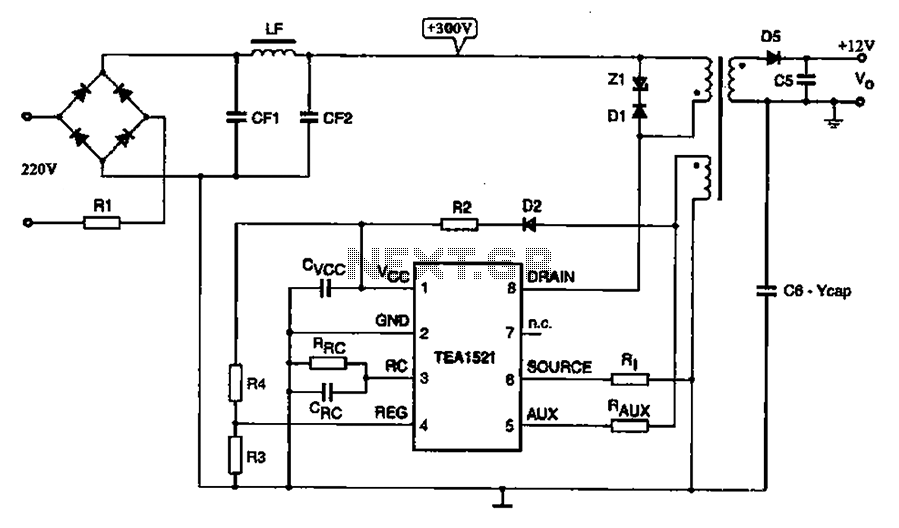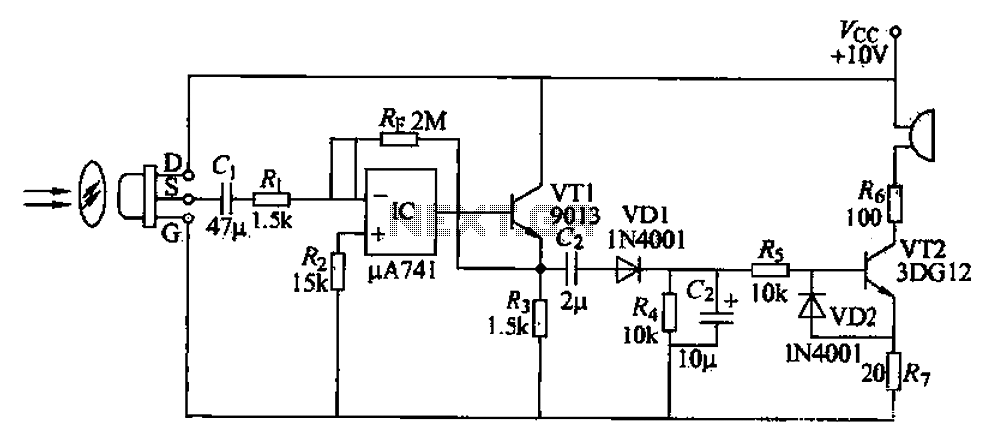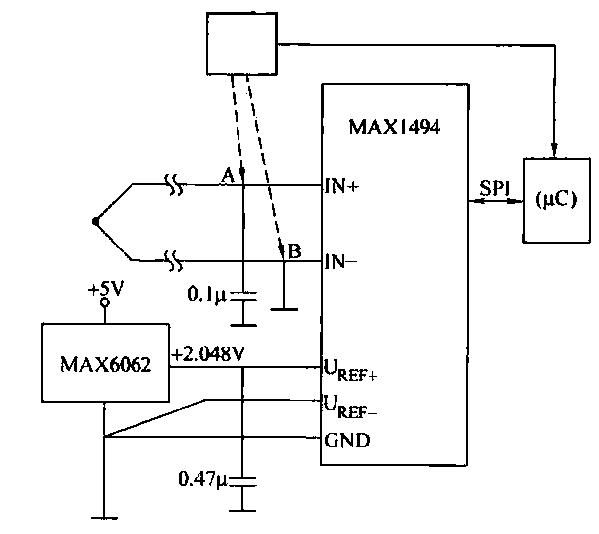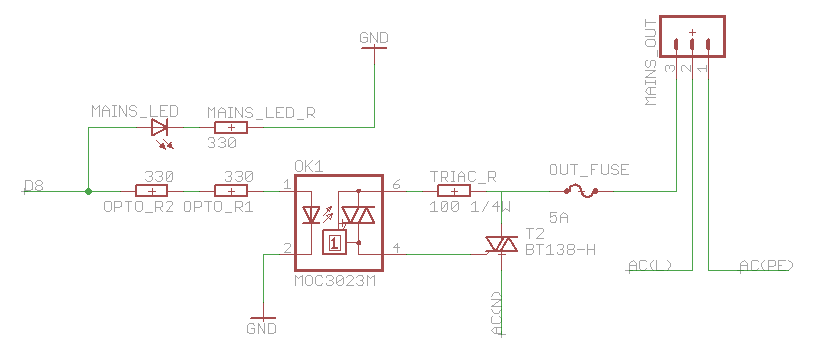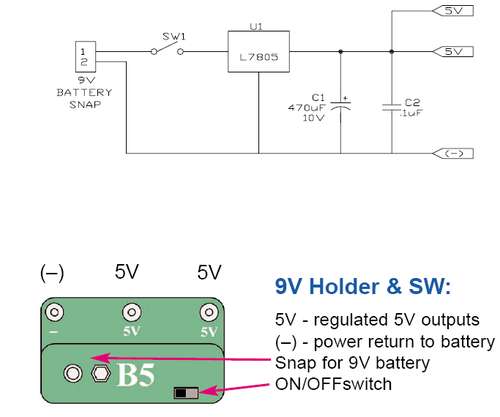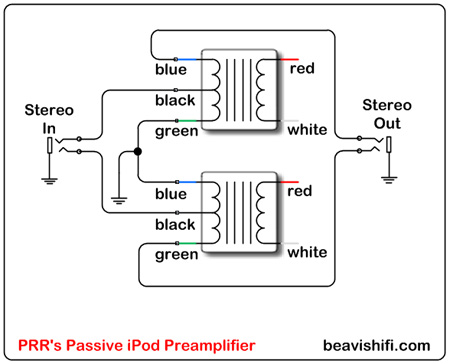
bd5460 class d amplifier circuit
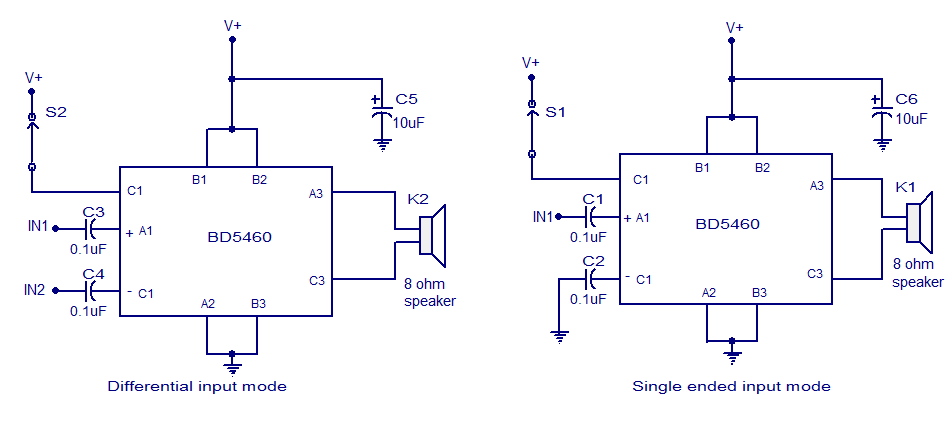
The BD5460 is a low power Class D amplifier that can be utilized in low power applications such as handheld audio devices. The BD5460 does not require an LC filter at the speaker output and can be powered by a battery. The standby current of the BD5460 is typically zero, eliminating any switch on/off clicks. It can deliver 0.8 watts into an 8-ohm speaker at a supply voltage of 3.6 V. The power supply voltage range is from 2.5 to 6.5 V DC. This integrated circuit (IC) features a built-in standby function, short circuit protection, thermal shutdown, and under-voltage lockout. Two Class D amplifier circuits utilizing the BD5460 are presented: the first is a differential input Class D amplifier, while the second is a single-ended input Class D amplifier. The 0.1 µF capacitors (C1, C2, C3, and C4) serve as input DC decoupling capacitors, which influence the lower interrupt frequency of the amplifier. The 10 µF capacitors (C5 and C6) act as power supply filters. S1 and S2 are the shutdown switches; connecting the C1 pin to a high logic level activates the IC, while grounding the C1 pin places the IC into shutdown mode.
The BD5460 Class D amplifier is designed for efficiency and compactness, making it an excellent choice for portable audio applications. Its ability to operate without an LC filter simplifies the design and reduces the overall component count, making it suitable for space-constrained environments. The amplifier's output capability of 0.8 watts into an 8-ohm load at a nominal voltage of 3.6 V allows for adequate audio performance in small devices, such as portable speakers and handheld gaming consoles.
The integrated standby function is particularly advantageous for battery-operated devices, as it helps to conserve power when the amplifier is not in use. The zero standby current ensures that battery life is maximized, which is critical in portable applications. The built-in short circuit protection and thermal shutdown features provide additional reliability, safeguarding the amplifier from damage due to overload conditions.
The circuit design includes two configurations for the BD5460, allowing designers to choose between a differential input and a single-ended input setup based on the application's requirements. The use of 0.1 µF decoupling capacitors is crucial for maintaining signal integrity by filtering out unwanted DC offsets and noise, which can affect the amplifier's performance. The 10 µF capacitors serve to stabilize the power supply, ensuring that the amplifier receives clean power for optimal operation.
Shutdown switches S1 and S2 provide a simple method to control the amplifier's operation. By toggling the C1 pin between a high logic level and ground, users can easily switch the amplifier on and off, enhancing user control over the device's power state.
Overall, the BD5460 is a versatile and efficient Class D amplifier that meets the demands of modern low-power audio applications, providing a reliable solution for designers seeking to implement high-quality audio in compact electronic devices.BD5460 is a low power {lass D amplifier that can be employed in low power applications like handheld audio devices. BD5460 doesn`t need an LC filter at the speaker output and can be driven employing a battery, The standby current of BA5460 is usually zero and there`s no switch on / OFF clicks.
The BD5460 can deliver 0. 8 watts into an 8 ohm speaker at 3. 6 V supply voltage. the power supply voltage range is from 2. 5 to 6. 5 V DC. The IC contains a built-in standby function, short circuit protection, thermal shutdown and below voltage lockout. Two class D amplifier circuits using BD5460 are shown here. the first one is a differential input class D amplifier while the second one is a single ended input class D amplifier.
The 0. 1uF capacitors (C1, C2, C3 and C4) are input DC decoupling capacitors. The lower interrupt frequency of the amplifier depends on these capacitors. 10uF capacitors (C5 and C6) are the power supply filters. S1 and S2 are the shutdown switches. Connecting the C1 pin to the high logic can create the IC active and connecting the C1 pin to ground will put the Ic into shutdown mode. 🔗 External reference
The BD5460 Class D amplifier is designed for efficiency and compactness, making it an excellent choice for portable audio applications. Its ability to operate without an LC filter simplifies the design and reduces the overall component count, making it suitable for space-constrained environments. The amplifier's output capability of 0.8 watts into an 8-ohm load at a nominal voltage of 3.6 V allows for adequate audio performance in small devices, such as portable speakers and handheld gaming consoles.
The integrated standby function is particularly advantageous for battery-operated devices, as it helps to conserve power when the amplifier is not in use. The zero standby current ensures that battery life is maximized, which is critical in portable applications. The built-in short circuit protection and thermal shutdown features provide additional reliability, safeguarding the amplifier from damage due to overload conditions.
The circuit design includes two configurations for the BD5460, allowing designers to choose between a differential input and a single-ended input setup based on the application's requirements. The use of 0.1 µF decoupling capacitors is crucial for maintaining signal integrity by filtering out unwanted DC offsets and noise, which can affect the amplifier's performance. The 10 µF capacitors serve to stabilize the power supply, ensuring that the amplifier receives clean power for optimal operation.
Shutdown switches S1 and S2 provide a simple method to control the amplifier's operation. By toggling the C1 pin between a high logic level and ground, users can easily switch the amplifier on and off, enhancing user control over the device's power state.
Overall, the BD5460 is a versatile and efficient Class D amplifier that meets the demands of modern low-power audio applications, providing a reliable solution for designers seeking to implement high-quality audio in compact electronic devices.BD5460 is a low power {lass D amplifier that can be employed in low power applications like handheld audio devices. BD5460 doesn`t need an LC filter at the speaker output and can be driven employing a battery, The standby current of BA5460 is usually zero and there`s no switch on / OFF clicks.
The BD5460 can deliver 0. 8 watts into an 8 ohm speaker at 3. 6 V supply voltage. the power supply voltage range is from 2. 5 to 6. 5 V DC. The IC contains a built-in standby function, short circuit protection, thermal shutdown and below voltage lockout. Two class D amplifier circuits using BD5460 are shown here. the first one is a differential input class D amplifier while the second one is a single ended input class D amplifier.
The 0. 1uF capacitors (C1, C2, C3 and C4) are input DC decoupling capacitors. The lower interrupt frequency of the amplifier depends on these capacitors. 10uF capacitors (C5 and C6) are the power supply filters. S1 and S2 are the shutdown switches. Connecting the C1 pin to the high logic can create the IC active and connecting the C1 pin to ground will put the Ic into shutdown mode. 🔗 External reference
Warning: include(partials/cookie-banner.php): Failed to open stream: Permission denied in /var/www/html/nextgr/view-circuit.php on line 713
Warning: include(): Failed opening 'partials/cookie-banner.php' for inclusion (include_path='.:/usr/share/php') in /var/www/html/nextgr/view-circuit.php on line 713
